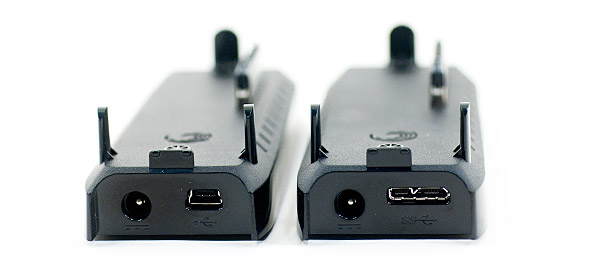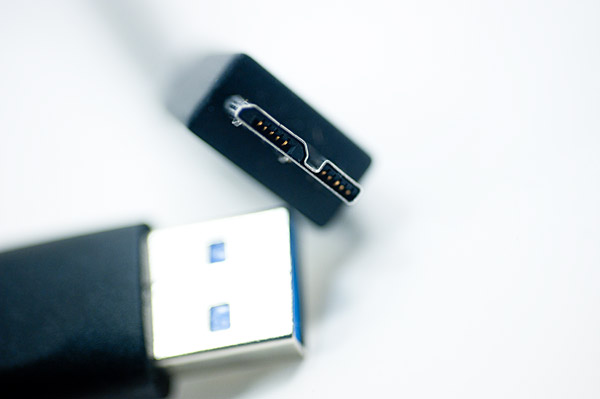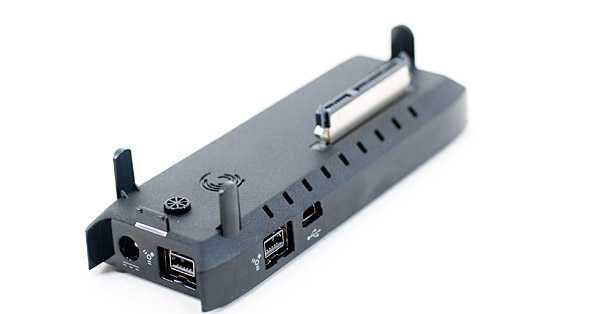The World's First 3TB HDD: Seagate GoFlex Desk 3TB Review
by Anand Lal Shimpi on August 23, 2010 12:39 AM EST- Posted in
- Storage
- Seagate
- HDDs
- GoFlex Desk
USB 2.0, 3.0 and FireWire 800 Performance
Seagate sent all three docks for review and I benchmarked the 3TB GoFlex Desk under both Windows 7 and Mac OS X 10.6.4 to get an idea for its performance. The full results are below, but I’ll give you the gist of it here.

USB 2.0 and USB 3.0 docks (left and right)
Over USB 2.0 I got around 30MB/s for sequential reads/writes. That’s 240Mbps, about half of the USB 2.0 spec maximum.
| Windows Performance Comparison | |||||
| Seagate GoFlex Desk 3TB (USB 2.0) | Seagate GoFlex Desk 3TB (USB 3.0) | ||||
| Sequential Read | 33.1 MB/s | 151.9 MB/s | |||
| Sequential Write | 26.9 MB/s | 151.2 MB/s | |||
| Random Read | 0.30 MB/s | 0.30 MB/s | |||
| Random Write | 0.93 MB/s | 0.93 MB/s | |||
USB 3.0 performance is just awesome, the drive performs just like an internal hard drive. It's a shame that USB 3.0 isn't more ubiquitous because this is great performance not to mention that you get backwards compatibility with USB 2.0 systems. The only issue is you need to make sure you don't lose the USB 3.0 cable since the drive-end of it is not backwards compatible.
I actually got better performance over USB 3.0 than I did with the drive connected via SATA at around 150MB/s for sequential reads/writes. The SATA to USB 3.0 bridge does some additional buffering that may be the cause of the improved performance here. Random performance remained unchanged regardless of what interface I used.

The USB 3.0 cable that ships with the GoFlex Desk USB 3.0 dock. It works in both USB 2.0 and USB 3.0 ports.
On the Mac, without Iometer I had to resort to XBench for the performance numbers. All of these are written via the filesystem but are uncached:
| Mac Performance Comparison - XBench 1.3 | |||||
| Seagate GoFlex Desk 3TB (USB 2.0) | Seagate GoFlex Desk 3TB (FireWire 800) | ||||
| Sequential Read | 17.0 MB/s | 74.9 MB/s | |||
| Sequential Write | 15.8 MB/s | 47.6 MB/s | |||
| Random Read | 0.68 MB/s | 0.73 MB/s | |||
| Random Write | 1.80 MB/s | 1.78 MB/s | |||
USB 2.0 performance was aroun 15 - 17MB/s while FireWire 800 managed 47.6MB/s for sequential writes and 75MB/s for sequential reads. Copying files to the drive manually I saw very similar numbers over FireWire 800 (53MB/s writes, 78MB/s reads). Note that performance was identical regardless of whether I was using Paragon’s NTFS driver or I formatted the drive in OS X’s native HFS+ file format.

FireWire 800
What this tells us is that, at least compared to FireWire 800 on a Mac Pro, the USB 3 connection in Windows is still the quickest way to write to the drive. There is one more stipulation that I must bring up. Most mainstream motherboards with an Intel chipset don’t give USB 3 controllers enough bandwidth to deliver these sorts of results. I was using a Gigabyte X58A-UD5, but many other boards dangle the USB 3 controller off of a single PCIe x1 lane running at 250MB/s (250MB/s each direction). In these cases you’ll still get better than USB 2.0 performance but you may not see the same numbers I got here.
I wrote about this issue while talking about 6Gbps SATA controllers on Intel motherboards here, but the same problem documented in that article applies to USB 3.0.










81 Comments
View All Comments
Aikouka - Monday, August 23, 2010 - link
There is a 120mm fan running air over the hard drives in question and there is an actual space in between the drives... they are not literally sitting on each other.The case is a Lian Li PC V2000B which has room for 10 HDDs in a 5x2 array. Optimally, I tried to leave an empty (HDD) space between each drive, but this was not entirely possible, so I had to not give them extra "breathing room."
While my spiel is technically purely anecdotal at best... I have similar WD drives that are working just fine and the one that was producing file read errors and hanging on reading files was the one that sat directly above the Seagate "Inferno." It is probably good to note that the WD drive was also one of their "Green" drives, which I assume also has lower temperature thresholds given that its a 5400RPM drive.
I still do run other Seagate drives in my PC, but I believe that they have that extra "buffer" between them and other drives now.
pcfxer - Tuesday, August 24, 2010 - link
Get some sexy hot-swap drive-bays for the 5.25" external slots. That way when you *need* the hot-swap compatible drive ccontroller you are set to show off your ZFS awesomeness.mewgirl - Monday, January 31, 2011 - link
There is a brand called i/O that lasted as long as I had it until it was stolen, never gave a single error, and connected properly to every computer I plugged it into, without having to go into disk manager, run commands, etc., to plug in. And MOST BENEFICIALLY it didn't come with any files on the disk. So (I don't remember the size of it), if it was a 300GB drive, then, when I plugged it in, it ACTUALLY SAID 300GB. It didn't even say 299.7. It said 300. If I remember correctly there was a scattered file or two on it, but I didn't think they were programs (but could have been wrong - notice I didn't even know what the double-cord was for at the time), and they didn't try to initiate themselves. But all it took to delete them was to hit "delete". And then it was listed as a full 300GB drive (or whatever size it was).Although, that particular brand name is a bit hard to Google. This was back when Google was actually a search engine, about 2 years ago (as in, it had other products, but the search engine actually worked?), and it took a while to find their website then. Which was done to find out why it came with an extra USB plug on the cord... one of those drives that has two USB plugs so you can plug in both if using only one makes it slow. AND it warns about overheating "only use both if you're having trouble". ANOTHER thing that is never done by other companies.
Then the Target closest to my dad;s house stopped selling it and I could never find it again.
loekf - Monday, August 23, 2010 - link
Call me biased, but I have used several WDC MyBooks and they never let me down. They have more room for ventilation. A few weeks I had this drive (2 TB) and after one day I had seen enough.Poorly designed, never wanted to go into standby/sleep mode and overheating.
Yes, you can disable the sleep mode, but then IT IS ALWAYS spanning when attached to your PC and Windows up and running. Even when you power-down your PC and you leave the drive connected to the mains, the drive is so stupid to power up again by itself.
ricamiller - Monday, August 23, 2010 - link
Why couldn't you just remove the hard drive from the case and insert it into something like a Thermaltake docking station with esata?There's no enclosure so wouldn't this solve the heat problem?
Drag0nFire - Monday, August 23, 2010 - link
Yeah, this confuses me too. But it's not just Seagate. All external manufacturers are doing it, from big names (Seagate, Samsung, WD) to off-brands (Fantom, Cavalry). Market factors push for a drive that is small (no space for air ventilation) and cheap (no money for quality metal materials to radiate heat).I recently had to RMA a Samsung HDD for this reason. Small package, no ventilation. It would heat up to 55C and then the SMART would register read/write errors. And this was a "low-power" 5400RPM drive!
I bought a WD green drive in an enclosure. Doesn't solve the heat problem, but those drives are pretty hearty and I'm using it only for backup. If I were to use it more extensively, I think the only solution is to buy a HDD and enclosure separately.
designerfx - Monday, August 23, 2010 - link
because they're too busy marketing external drives as the next best thing, when people don't realize how horrid most external drive solutions are when it comes to temperature.Not only that, but it's a humorous double win for HDD manufacturers (and double loss for consumers). They're charging you *more* than to buy it with an enclosure , and it will burn out years faster! double win as far as money goes.
2TB internal: $100 now. 2TB External - $125-150 (enclosures are a piece of plastic that costs them next to nothing to manufacture and they are usually priced at 25-50).. Not only that, but if the enclosure doesn't support USB3 or Sata2, you might lose it (even if the internal hard drive supports it).
jjzeal007 - Thursday, September 16, 2010 - link
Remember Google's study of 100,000 SATA/PATA hard drives in its data centers?One conclusion: There isn't as much of a correlation between drive temperature and failure rate as might be expected... excessively cooled drives actually failed more often than drives that ran a bit hot.
http://www.engadget.com/2007/02/18/massive-google-...
Wolfpup - Thursday, September 16, 2010 - link
Yeah, I'm just baffled by how products like this keep getting released to the public by tech companies. That's COMPLETELY unacceptable.What's nuts is in every other way it seems perfect for what it is! I was interested in buying one until getting to the heat issue
taltamir - Wednesday, October 20, 2010 - link
engineers can only point out problems and solution, management then decides NOT to implement them to save money.In the xbox RROD, the xbox scratched disks, and many other cases there are documentations showing that the engineers pointed out the problem and devised a solution... management decided its not worth the money and that they know better.